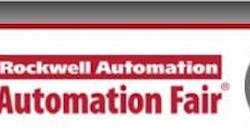A critical requirement of smart manufacturing initiatives such as Industrie 4.0 and China 2025 is the ability to communicate data and information throughout, between and among sensors, controls and information systems. The keynote presentation at the Automation Perspectives press event before Automation Fair described the growing role of communications in improving return on investment for industrial facilities, and how The Connected Enterprise from Rockwell Automation provides them.
“Our 25th anniversary Automation Fair brings us back to Atlanta,” said Blake Moret, president and CEO, Rockwell Automation. “Our second Automation Fair was also in Atlanta. At the time, I was a young sales engineer in our Atlanta office. Among the clients I called on were Coca-Cola and Southwire, and I’m happy to say they’re still good customers. Rockwell Automation has a rock-solid legacy, and we’re taking it forward.”
Global trends show the path forward
Moret identified three major trends driving today’s competitive industrial environment. First, the rise of the middle class in emerging economies means we must compete in their markets, and with them for our business.
Second, the need for more people who can deal with technology: the skills gap. In the U.S. alone, there are hundreds of thousands of good manufacturing jobs going unfilled for lack of people with the right skills and talent for today’s environment, and this is also true around the world. Automation people are retiring, and struggling to replace themselves.
Finally, of course, is globalization itself. “We all compete against the very best in the world, all the time,” Moret said.
On the positive side, the lowering cost of connectivity is driving productivity. Component and equipment prices are dropping rapidly, “and the multiple networks we’ve been using for the field, control and the enterprise are collapsing and converging on Ethernet as the cost of a point falls,” Moret said.
[sidebar id =1]Information management and analytics are offering another level of productivity and are increasingly taking place in instruments and controllers, as well as on servers and in the cloud.
“Countries recognize the opportunity to facilitate productivity, to get the home-field advantage with connectivity,” Moret said. “China 2025 is mandatory—companies must adopt it, and they are.” Industrie 4.0 is on everybody’s mind, with its opportunities to unlock unprecedented productivity.
Rockwell Automation has a strategy to implement the needed connectivity. “We call it The Connected Enterprise,” Moret said. “You can use it to get to market faster, to lower total cost of ownership, to reduce unplanned downtime, and to manage enterprise risk and compliance.”
Bring IT to OT
An important enabler is the convergence of IT and operations technology (OT), taking the best from commercial technology and practices. “We offer this in service-level agreements where our value-add is expertise in the applications,” Moret said. “IT provides the know-how to sift data, and we know where to look.”
Data is born on plant-level devices and brought up through controls into information systems to help operations make better decisions and be more productive. “We can do this on one network,” Moret said. “We apply these concepts in our own facilities. They’re not as automation-intensive as many of our customers’ sites—we have lots of manual operations—but the benefits have been amazing and they come from the basics.”
[sidebar id =2]By understanding work practices and potential savings, Rockwell Automation plants have reduced work in process (WIP), error-proofed procedures and reduced rework. “Results like ‘reduced time to market’ are tangible and drive sales for us,” Moret said. “Each plant starts from a unique point, with its own opportunities to add value.”
In Phase 2, the company is adding data streams from its supply chains, using the cloud to complement onsite systems. “In the end, it doesn’t reduce the number of people, but it does change their work,” Moret added. And it provides insight Rockwell Automation can apply to customers. “Out in the market, there’s not a lot of new capital investment going on—most projects are brownfield upgrades and expansions. We must catch customers at that point in their history, not as greenfield projects.
“We need to understand the customers’ applications, to help define their best opportunities to increase productivity. We have those capabilities and we’re adding more.”
Add IIoT and STEM
“There’s been a lot of general conversation about the Industrial Internet of Things (IIoT), and now we’re starting to make it real in applications such as serialization, track and trace, compliance and scheduling,” Moret said.
The company has used connectivity to optimize uptime and productivity of well heads and to increase yields in mining. Faribault Foods uses it on a heat energy recovery system; ZMC Pharmaceuticals, for a paperless MES; and Ford, to add mobility and monitoring.
“We’re partnering with Microsoft and Cisco, and we’re making acquisitions, recently of ACP for security and Maverick for domain expertise in batch control,” Moret said. “We have to have our own internal knowledge to help our customers, and to inform our own internal roadmap.”
An important part of the Rockwell Automation connectivity strategy is filling the pipeline with people who can—and want to—do the work. Companies need to start even earlier to help develop industrial automation skills and capabilities.
The company has long been a supporter of education in science, technology, engineering and math (STEM), and on this 25th anniversary of Automation Fair, “We’re taking that support to a new level with a four-year, $12 million gift to FIRST Robotics,” Moret said. “That’s a lot of money—the biggest gift they’ve ever received, and the biggest we’ve ever made.”
[sidebar id =3]




